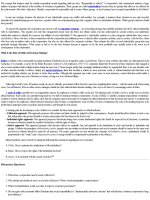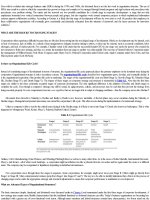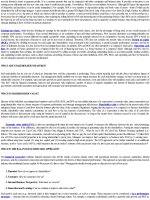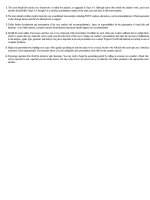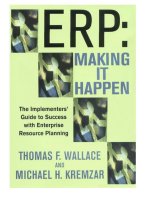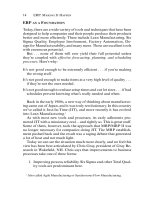Essentials of strategic management 3rd edition jones
Bạn đang xem bản rút gọn của tài liệu. Xem và tải ngay bản đầy đủ của tài liệu tại đây (6.13 MB, 421 trang )
M A K E T H E G R A D E W I T H C O U R S E M AT E !
The more you study, the better the results. Cengage Learning’s Management
CourseMate helps you make the most of your study time by accessing
everything you need to succeed in one place.
features include:
• An Interactive eBook with
highlighting, note taking, and an
interactive glossary.
• Interactive Learning Tools—
read your textbook, take notes,
review flashcards, watch videos, and
take practice quizzes—online with
CourseMate.
• It’s Affordable—about half the cost
of a traditional printed textbook.
To access additional course materials including CourseMate, please visit
www.cengagebrain.com. At the CengageBrain.com home page, enter the ISBN of
your title (from the back cover of your book) using the search box at the top of the
page. This will take you to the product page where these resources can be found.
This page intentionally left blank
3rd Edition
Essentials of
Strategic Management
Charles W. L. Hill
University of Washington
Gareth R. Jones
Texas A&M University
Australia • Brazil • Japan • Korea • Mexico • Singapore • Spain • United Kingdom • United States
This is an electronic version of the print textbook. Due to electronic rights restrictions,
some third party content may be suppressed. Editorial review has deemed that any suppressed
content does not materially affect the overall learning experience. The publisher reserves the right
to remove content from this title at any time if subsequent rights restrictions require it. For
valuable information on pricing, previous editions, changes to current editions, and alternate
formats, please visit www.cengage.com/highered to search by ISBN#, author, title, or keyword for
materials in your areas of interest.
Essentials of Strategic Management,
Third Edition
Charles W. L. Hill, Gareth R. Jones
Vice President of Editorial, Business:
Jack W. Calhoun
Acquisitions Editor: Michele Rhoades
Developmental Editor: Suzanna Bainbridge
Senior Editorial Assistant: Ruth Belanger
© 2012, 2009 South-Western, Cengage Learning
ALL RIGHTS RESERVED. No part of this work covered by the copyright
herein may be reproduced, transmitted, stored, or used in any form
or by any means graphic, electronic, or mechanical, including but not
limited to photocopying, recording, scanning, digitizing, taping, web
distribution, information networks, or information storage and retrieval
systems, except as permitted under Section 107 or 108 of the 1976
United States Copyright Act, without the prior written permission
of the publisher.
Marketing Manager: Jon Monahan
Associate Content Project Manager:
Jana Lewis
Media Editor: Rob Ellington
Frontlist Buyer, Manufacturing:
Arethea Thomas
Marketing Communications Manager:
Jim Overly
Production Service:
S4Carlisle Publishing Services
Art Director: Tippy McIntosh
Internal Designer: Mike Stratton,
Stratton Design
Cover Designer: Mike Stratton,
Stratton Design
Cover Image: © sndr, iStock
Rights Acquisitions Specialist: John Hill
For product information and technology assistance, contact us at
Cengage Learning Customer & Sales Support, 1-800-354-9706
For permission to use material from this text or product,
submit all requests online at www.cengage.com/permissions
Further permissions questions can be emailed to
ExamView ® is a registered trademark of eInstruction Corp. Windows is
a registered trademark of the Microsoft Corporation used herein under
license. Macintosh and Power Macintosh are registered trademarks of
Apple Computer, Inc. used herein under license.
© 2008 Cengage Learning. All Rights Reserved.
Cengage Learning WebTutor™ is a trademark of Cengage Learning.
Library of Congress Control Number: 2011925165
ISBN-13: 978-1-111-52519-4
ISBN-10: 1-111-52519-6
South-Western
5191 Natorp Boulevard
Mason, OH 45040
USA
Cengage Learning products are represented in Canada by
Nelson Education, Ltd.
For your course and learning solutions, visit www.cengage.com
Purchase any of our products at your local college store or at our
preferred online store www.cengagebrain.com
Unless a credit line states otherwise, content is the property
of Cengage Learning.
Printed in the Canada
1 2 3 4 5 6 7 15 14 13 12 11
Brief Contents
PART ONE
1
2
INTRODUCTION TO STRATEGIC MANAGEMENT
The Strategy-Making Process
Stakeholders, The Mission, Governance, and Business Ethics
1
27
PART TWO THE NATURE OF COMPETITIVE ADVANTAGE
3
4
External Analysis: The Identification of Opportunities
and Threats
Building Competitive Advantage
PART THREE
5
6
7
8
9
BUILDING AND SUSTAINING LONG-RUN
COMPETITIVE ADVANTAGE
Business-Level Strategy and Competitive Positioning
Strategy in the Global Environment
Corporate-Level Strategy and Long-Run Profitability
PART FOUR
55
83
117
145
172
STRATEGY IMPLEMENTATION
Strategic Change: Implementing Strategies to Build
and Develop a Company
Implementing Strategy Through Organizational Design
200
226
iii
iv
Contents
Contents
Preface
PART ONE
Chapter 1
xi
INTRODUCTION TO STRATEGIC MANAGEMENT
The Strategy-Making Process
1
Competitive Advantage and Superior Performance
2
Running Case: Walmart’s Competitive Advantage 3
Strategic Managers 5
Corporate-Level Managers 6
Business-Level Managers 6
Functional-Level Managers 7
The Strategy-Making Process 7
A Model of the Strategic Planning Process 7
The Feedback Loop 11
Strategy as an Emergent Process 11
Strategy Making in an Unpredictable World 11
Autonomous Action: Strategy Making by Lower-Level Managers
Serendipity and Strategy 12
Strategy in Action 1.1: A Strategic Shift at Microsoft
Intended and Emergent Strategies 14
Strategic Planning in Practice 15
Scenario Planning 15
Decentralized Planning 16
Strategic Decision Making 17
Cognitive Biases 17
Improving Decision Making 18
Strategic Leadership 19
Vision, Eloquence, and Consistency 19
Commitment 20
Being Well Informed 20
Willingness to Delegate and Empower 20
The Astute Use of Power 21
Emotional Intelligence 21
Practicing Strategic Management 23
Closing Case: Planning for the Chevy Volt
iv
24
13
12
Contents
Chapter 2
Stakeholders, The Mission, Governance,
and Business Ethics
Stakeholders 28
The Mission Statement 29
The Mission 30
Vision 31
Values 32
Major Goals 32
Corporate Governance and Strategy
The Agency Problem 34
v
27
33
Strategy In Action 2.1: The Agency Problem at Tyco
Governance Mechanisms 38
Ethics and Strategy 42
Ethical Issues in Strategy 42
35
Running Case: Working Conditions at Walmart 45
The Roots of Unethical Behavior 46
Behaving Ethically 47
Final Words 49
Practicing Strategic Management 51
Closing Case: Google’s Mission, Ethical Principles, and Involvement
in China 52
PART TWO THE NATURE OF COMPETITIVE ADVANTAGE
Chapter 3
External Analysis: The Identification
of Opportunities and Threats
Analyzing Industry Structure 56
Risk of Entry by Potential Competitors
55
58
Strategy in Action 3.1: Circumventing Entry Barriers into
the Soft Drink Industry 59
Rivalry among Established Companies 61
The Bargaining Power of Buyers 63
The Bargaining Power of Suppliers 64
Substitute Products 65
Porter’s Model Summarized 66
Strategic Groups within Industries 66
Running Case: Walmart’s Bargaining Power over Suppliers
Implications of Strategic Groups 68
67
vi
Contents
The Role of Mobility Barriers 69
Industry Life Cycle Analysis 69
Embryonic Industries 70
Growth Industries 70
Industry Shakeout 71
Mature Industries 72
Declining Industries 72
Summary 73
The Macroenvironment 73
Macroeconomic Forces 73
Global Forces 75
Technological Forces 75
Demographic Forces 75
Social Forces 76
Political and Legal Forces 76
Practicing Strategic Management 78
Closing Case: The Pharmaceutical Industry
Chapter 4
79
Building Competitive Advantage
83
Competitive Advantage: Value Creation, Low Cost,
and Differentiation 84
The Generic Building Blocks of Competitive Advantage 86
Efficiency 87
Quality as Excellence and Reliability 88
Innovation 89
Customer Responsiveness 90
The Value Chain 90
Primary Activities 91
Support Activities 92
Functional Strategies and The Generic Building Blocks of Competitive
Advantage 93
Increasing Efficiency 93
Strategy in Action 4.1: Learning Effects in Cardiac Surgery
Running Case: Human Resource Strategy and Productivity
at Walmart 99
Increasing Quality 100
Increasing Innovation 103
Achieving Superior Customer Responsiveness 106
Distinctive Competencies and Competitive Advantage 108
Resources and Capabilities 108
The Durability of Competitive Advantage 110
Practicing Strategic Management
Closing Case: Starbucks 113
112
95
Contents
PART THREE
Chapter 5
vii
BUILDING AND SUSTAINING LONG-RUN
COMPETITIVE ADVANTAGE
Business-Level Strategy and Competitive Positioning
117
The Nature of Competitive Positioning 118
Customer Needs and Product Differentiation 118
Customer Groups and Market Segmentation 119
Distinctive Competencies 119
Running Case: Walmart’s Business Model and Competitive
Positioning 120
Choosing a Business-Level Strategy 120
Cost-Leadership Strategy 121
Differentiation Strategy 122
Cost Leadership and Differentiation 124
Focus Strategy 125
Stuck in the Middle 128
Competitive Positioning in Different Industry Environments 129
Strategies in Fragmented and Growing Industries 129
Strategy in Mature Industries 131
Strategies in Declining Industries 137
Practicing Strategic Management 141
Closing Case: Nike’s Business-Level Strategies
Chapter 6
142
Strategy in the Global Environment
145
The Global Environment 146
Increasing Profitability through Global Expansion 148
Expanding the Market: Leveraging Products and Competencies
Realizing Economies of Scale 149
Realizing Location Economies 149
Running Case: Walmart’s Global Expansion 150
Leveraging the Skills of Global Subsidiaries 152
Cost Pressures and Pressures for Local Responsiveness
Pressures for Cost Reductions 153
Pressures for Local Responsiveness 154
Choosing a Global Strategy 156
Global Standardization Strategy 156
Localization Strategy 157
152
Strategy in Action 6.1: The Evolution of Strategy at Procter &
Gamble 158
Transnational Strategy 159
International Strategy 159
Changes in Strategy Over Time 160
148
viii
Contents
Choices of Entry Mode 161
Exporting 161
Licensing 162
Franchising 163
Joint Ventures 164
Wholly Owned Subsidiaries 165
Choosing an Entry Strategy 166
Practicing Strategic Management 169
Closing Case: IKEA—The Global Retailer
Chapter 7
169
Corporate-Level Strategy and Long-Run Profitability
Concentration on a Single Industry 173
Horizontal Integration 174
Benefits and Costs of Horizontal Integration
172
175
Running Case: Walmart’s Growing Chain of “Neighborhood
Markets” 176
Outsourcing Functional Activities 178
Vertical Integration 180
Arguments for Vertical Integration 182
Arguments against Vertical Integration 184
Vertical Integration and Outsourcing 186
Entering New Industries Through Diversification 186
Creating Value Through Diversification 187
Strategy in Action 7.1: Diversification at 3M: Leveraging Technology
Related versus Unrelated Diversification 191
Restructuring and Downsizing 192
Why Restructure? 193
Exit Strategies 194
Practicing Strategic Management 196
Closing Case: United Technologies Has an “ACE in Its Pocket”
PART FOUR
Chapter 8
190
197
STRATEGY IMPLEMENTATION
Strategic Change: Implementing Strategies
to Build and Develop a Company
Strategic Change 201
Types of Strategic Change 201
A Model of the Change Process 202
Analyzing a Company as a Portfolio of Core Competencies
Fill in the Blanks 206
Premier Plus 10 207
200
205
Contents
ix
White Spaces 207
Mega-Opportunities 207
Implementing Strategy Through Internal New Ventures 208
Pitfalls with Internal New Ventures 209
Guidelines for Successful Internal New Venturing 211
Implementing Strategy Through Acquisitions 212
Pitfalls with Acquisitions 213
Guidelines for Successful Acquisition 214
Implementing Strategy Through Strategic Alliances 215
Strategy in Action 8.1: News Corp’s Successful Acquisition Strategy
Advantages of Strategic Alliances 217
Disadvantages of Strategic Alliances 217
Making Strategic Alliances Work 218
Practicing Strategic Management 222
Closing Case: Oracle’s Growing Portfolio of Businesses
Chapter 9
223
Implementing Strategy Through Organizational Design
The Role of Organizational Structure 227
Building Blocks of Organizational Structure
Vertical Differentiation 229
Problems with Tall Structures 230
Centralization or Decentralization? 232
228
Strategy in Action 9.1: To Centralize or Decentralize?
That Is the Question 233
Horizontal Differentiation 234
Functional Structure 234
Product Structure 236
Product-Team Structure 237
Geographic Structure 238
Multidivisional Structure 240
Integration and Organizational Control 244
Forms of Integrating Mechanisms 244
Differentiation and Integration 247
The Nature of Organizational Control 247
Strategic Controls 248
Financial Controls 250
Output Controls 251
Behavior Control 252
Running Case: How Sam Walton Created Walmart’s Culture
Practicing Strategic Management 257
Closing Case: Strategy Implementation at Dell Computer
216
255
258
226
x
Contents
Introduction: Analyzing a Case Study
and Writing a Case Study Analysis
C1
What Is Case Study Analysis?
Analyzing a Case Study
Writing a Case Study Analysis
The Role of Financial Analysis in Case Study Analysis
Profit Ratios
Liquidity Ratios
Activity Ratios
Leverage Ratios
Shareholder-Return Ratios
Cash Flow
Conclusion
Cases
Analyzing a Case Study and Writing a Case Study Analysis
C1
Section A: Business Level Cases: Domestic and Global
Case 1: Apple in 2008
C13
Case 2: SGI versus Dell: Competition in Server and Cloud
Computing C27
Case 3: The Home Video Game Industry: Atari Pong
to the Nintendo Wii C35
Case 4: McDonald’s and Its Critics: 1973–2009
C53
Case 5: The Global Automobile Industry in 2009
C66
Case 6: General Motors: From Birth to Bankruptcy in 2009
C78
Section B: Corporate Level Cases: Domestic and Global
Case 7: IKEA: Furniture Retailer to the World
Case 8: The Rise of IBM
C98
Case 9: The Fall of IBM
C109
Case 10: IBM in 2009
Index
C90
C122
I1
Preface
In framing and writing Essentials of Strategic Management, our goal is to inform
and familiarize students with what strategic management means to today’s global
world. Often people are unaware of how the strategy-making process affects them.
We are all used to going to work and going into companies such as restaurants,
stores, and banks, and buying the goods and services we need to satisfy our many
needs. However, the actual strategic management activities and processes that are required to make these goods and services available to us commonly go unappreciated.
Similarly, we might know that companies exist to make a “profit,” but what is profit,
how is it created, and what is profit used for? Moreover, what are the actual strategic
management activities involved in the creation of goods and services, and why is it
that some companies seem to be more effective and more “profitable” than others?
Essentials of Strategic Management, Third Edition, has been structured and written to address these issues. The goal of this revision is to explain in a clear, comprehensive, but concise way why strategic management is important to people, the
companies they work for, and the society in which they live. Our objective in writing
this book has been to provide the overall “big picture” of what strategic management is, what strategic managers do, and how the strategy-making process affects
company performance. The book provides a focused, integrated approach that gives
students a solid understanding of the nature, functions, and main building blocks of
strategic management.
Organization of the Book
The book presents a broad overview of the nature and functions of strategic management in nine chapters. Part 1, Introduction to Strategic Management, explains
what strategic management is and provides a framework to understand what strategic managers do. Chapter 1 discusses the relationship between strategic management
and strategic leadership and shows how competitive advantage results in superior
performance. It also describes the plan of this book and discusses the principal functions of strategic managers. Chapter 2 discusses the way companies affect their
stakeholders, and why it is necessary to create corporate governance mechanisms
that ensure strategic managers work to further the interests of stakeholders and
behave ethically.
In Part 2, The Nature of Competitive Advantage, we discuss the factors and
forces both external and internal to an organization that determine its choice of
strategies to create a competitive advantage and achieve above-average profitability.
Chapter 3 discusses opportunities, threats, and competition in the external environment. Chapter 4 examines how a company can build competitive advantage by
achieving superior efficiency, quality, innovation, and responsiveness to customers. It
also discusses how managers can craft functional-level strategies that will allow an
organization to achieve these goals.
xi
xii
Preface
In Part 3, Building and Sustaining Long-Run Competitive Advantage, we provide
a streamlined discussion of the different level of strategy that must be developed
to build and sustain a long-term competitive advantage. Chapter 5 discusses how
to use business-level strategies to optimize competitive positioning and outperform
industry rivals. Chapter 6 discusses how to strengthen competitive advantage by
expanding globally into new national markets. Chapter 7 then examines the various
corporate-level strategies such as vertical integration, diversification, and outsourcing that are used to protect and strengthen competitive advantage and sustain longrun profitability.
Part 4, Strategy Implementation, we examine the many operational issues involved in putting all these strategies into action simultaneously. Chapter 8 first
discusses the importance of strategic change in today’s fast-changing global environment and the issues and problems involved in managing the change process effectively. Then, it outlines how to build and develop a company’s business through
the use of internal new venturing, acquisitions, and strategic alliances and considers
the pros and cons of these different methods. Chapter 9 discusses how to implement
strategy through the design of organizational structure and the operational issues
involved in selecting structures to match the needs of particular strategies. It also
discusses the organizational control systems necessary to fit strategy to structure and
the role of organizational culture in developing competitive advantage.
And, finally, in Part 5 we provide a collection of cases that will appeal to students
and instructors alike. We selected cases based both on the intrinsically interesting
and timely topics, such as the global auto industry and the gaming industry, and the
strategic management issues they illuminate. Through the cases and the guidelines
on analyzing a case, students can further investigate the successes and challenges
presented throughout the strategic management process. All ten cases are new to this
edition and strive to introduce students to well-known global corporations such as
Apple, Dell, McDonald’s, IKEA, and IBM.
As you can see by perusing the table of contents, our essentials book parallels
the approach we take in our other book, Strategic Management: An Integrated
Approach. Our goal is to offer a contemporary, integrated account of strategic management, but one that is streamlined and focused only on the essentials of this complex and fascinating subject.
Learning Features
Nothing makes the practice of strategic management come alive more than vivid stories and examples about people and companies that demonstrate clearly the meaning
of the chapter material. Hands-on exercises offer students the opportunity to actively think about and engage in strategic management issues and decision making.
This book pays considerable attention to creating and developing both in-chapter
and end-of-chapter features and exercises to offer the most learning value to students while economizing on their valuable learning time.
Each chapter contains Strategy in Action insight boxes that have been carefully
selected and written to raise students’ interest and are integrated seamlessly into the
text so as not to disrupt its flow. Many books have examples that disrupt students’
thought processes or distract them with enormous amounts of unnecessary detail;
this book avoids these pitfalls.
Preface
Each chapter also contains a Running Case featuring Walmart as the focus corporation. In this edition, the Running Case examples illustrating continuous realworld changes in strategic management practices such as the increased use of cost
reduction strategies like global outsourcing, ethical issues, and lean production are
at the heart of the revision.
In midst of ever-present corporate scandals and economic turbulence, educators
are faced with the critical and difficult task of teaching ethical decision-making practices. As an instructional tool to broach this task, each chapter contains the new marginal feature—Ethical Dilemma—that asks students to make sound management
decisions while considering ethical ramifications in business.
The end-of-chapter learning features contained in Practicing Strategic
Management are composed of exercises designed to offer additional insight into the
chapter material to build students’ learning experience. They are designed to create
lively discussion either at the level of the whole class, or in small groups, or at the
individual level. In practice, an instructor will have to decide which of these exercises
to select and use in any particular class period or which to use as homework assignments. Frequently, instructors find that varying the particular exercises they use over
the semester is the best way to engage students.
•
•
•
•
Discussion Questions. A set of chapter-related questions and points for reflection, some of which ask students to research actual management issues and learn
firsthand from practicing managers.
Small-Group Exercise. This exercise is designed to allow instructors to utilize interactive experiential exercises in groups of three to four students. Each chapter contains
a chapter-related issue guaranteed to lead to debate among students. The instructor
calls on students to break up into small groups—simply by turning to people around
them—and all students participate in the exercise in class. A mechanism is provided
for the different groups to share what they have learned with each other.
Exploring the Web. This exercise asks the student to visit the Web site of a company and then to use the information contained on that Web site to answer a
series of chapter-related questions.
Closing Case. Each chapter ends with a short case that can be used for further
analysis of chapter issues. They have been carefully chosen to reflect contemporary issues and problems in strategic management, and to offer further information on chapter issues. The accompanying discussion questions encourage
students to read about and to analyze how managers approach real problems in
the strategic management world.
Teaching and Learning Aids
For the Instructor
•
The Instructor’s Resource Manual (available on the IRCD or via the passwordprotected instructor Web site): For each chapter, we provide a clearly focused
synopsis, a list of teaching objectives, a comprehensive lecture outline, teaching
notes for the Ethical Dilemma feature, suggested answers to discussion questions,
and comments on the end-of-chapter activities. Each Opening Case, Strategy in
Action boxed feature, and Closing Case has a synopsis and a corresponding
teaching note to help guide class discussion.
xiii
xiv
Preface
•
•
•
•
•
•
•
•
ExamView Test Bank (available on the IRCD) offers a set of comprehensive true/
false, multiple-choice, and essay questions for each chapter in the book. The mix
of questions has been adjusted to provide fewer fact-based of simple memorization items and to provide more items that rely on synthesis or application. Every
question contains AACSB standardized tags, is keyed to text Learning Objective,
includes an answer, and text page reference.
Case Teaching Notes (available on the IRCD or via the password protected instructor website) include a complete list of case discussion questions as well as a comprehensive teaching note for each case, which gives a complete analysis of case issues.
PowerPoint (available on the IRCD or via the password-protected instructor
Web site) offer value to enhance your in-class lecture.
DVD program highlights many issues of interest and can be used to spark class discussion. It features extensive footage from “The Age of Walmart” series, CNBC’s
“Innovate or Die,” “The Execution Plan,” as well as other highly valuable segments that will enrich your students’ understanding and learning experience.
Online Resources: To access the online course materials, including CourseMate
(the text-specific Web site), visit www.cengagebrain.com. At the CengageBrain
.com home page, search for the ISBN of your title (from the back cover of your
book) using the search box at the top of the page. This will take you to the product page where these resources can be found.
Specific online resources to aid instructors include, the Instructor’s Manual,
a DVD guide, instructor-based PowerPoint, and access to the student protected
resources.
WebTutor: Jumpstart your course with customizable, rich text specific content
within your Course Management System!
• Jumpstart—Instructors simply load a WebTutor cartridge or epack into their
Course Management System.
• Content—Rich text specific content, media assets, quizzing, Weblinks, discussion topics, interactive games and exercises, and more.
• Customizable—Instructor can easily blend, add, edit, reorganize, or delete
content.
Whether you want to Web-enable your class or put an entire course online,
WebTutor delivers! Visit cengage.com/TeamUp/webtutor to learn more.
Simulations: Would you like to find a more creative way to have your students apply the concepts of Strategic Management? Take a moment to review one of our
simulation options for Strategic Management and see where the rubber meets the
road! Our simulations offer students the ability to fully run a company by making
key decisions, experiencing issues, and adjust their strategy based on the competition and the market. It’s an excellent way to fully immerse them in the content of the
course by having them experience the challenges and successes of business owners
everywhere. Contact your Cengage representative for details and a demonstration.
Write Experience allows instructors to assess written communication skills
without adding to your workload! Instructors in all areas have told us it’s important that students can write effectively in order to communicate and think
critically. Through an exclusive partnership with a technology company, Cengage
Learning’s Write Experience allows them to do just that! This new product utilizes artificial intelligence to not only score student writing instantly and accurately, but also provide students with detailed revision goals and feedback on
their writing to help them improve.
Find out more at www.cengage.com/writeexperience.
Preface
For the Student
•
CourseMate: Engaging, trackable, and affordable, the new Understanding
Business Strategy CourseMate Web site offers a dynamic way to bring course
concepts to life with interactive learning, study, and exam preparation tools that
support this printed edition of the text. Watch comprehension soar with all-new
flash cards, engaging games, streaming videos, and more in this textbook-specific
Web site. A complete e-book provides the choice of an entire online learning
experience. CourseMate goes beyond the book to deliver what you need!
• CengageBrain.com: Cengage Learning is excited to offer CengageBrain.com.
Students can choose to purchase the format that suits them best—print or
digital—and experience substantial savings options, including our new textbook
rental. To access additional course materials and companion resources, please
visit the home page and enter the ISBN of your title (from the back cover) using
the search box at the top of the page. This will take you to the product page
where these resources can be found.
Acknowledgments
Finding a way to integrate and present an overview of the rapidly changing world
of strategic management and strategic management activities and make it interesting
and meaningful for students is not an easy task. In writing Essentials of Strategic
Management, we have been fortunate to have had the assistance of several people
who contributed greatly to the book’s final form.
We are indebted to the many colleagues and reviewers who provided us with
useful and detailed feedback, perceptive comments, valuable suggestions for improving the manuscript. As well as those individuals have helped create and shape our
support package.
Kevin Banning, Auburn University
Robert D’Intino, Rowan University
Scott Droege, Western Kentucky University
Deborah Francis, Brevard College
Sanjay Goel, University of Minnesota
Leslie Haugen, University of St. Thomas
Todd Hostager, University of Wisconsin–Eau Claire
John Humphreys, Eastern New Mexico University
Deborah Johnson, Franklin University
Kevin L. Johnson, Baylor University
Elene Kent, Capital University
Subodh Kulkarni, Howard University
Kamalesh Kumar, University of Michigan–Dearborn
Paul Mallette, Colorado State University
Josetta McLaughlin, Roosevelt University
Tom Morris, Radford University
David Olson, California State–Bakersfield
William Ritchie, Florida Gulf Coast University
Tim Rogers, Ozarks Technical College
Stuart Rosenberg, Dowling College
xv
xvi
Preface
Manjula Salimath, University of North Texas
Thomas Sgritta, University of North Carolina–Charlotte
ChanChai Tangpong, North Dakota State University
Michael Wakefield, Colorado State University–Pueblo
Edward Ward, St. Cloud State University
Kenneth Wendeln, University of San Diego
Garland Wiggs, Hamline University
Jun Zhao, Governors State University
We are grateful to the individuals at Cengage Learning for their support and commitment to Essentials of Strategic Management, 3rd Edition. Specifically, we’d
like to thank Michele Rhoades, our acquisitions editor, Suzanna Bainbridge, our
development editor, Jana Lewis, Rob Ellington, Jonathan Monahan, and all the
other individuals that so ably coordinate the book’s progress. All these people
have been instrumental in creating a product we hope will meet its goal of helping
students better understand strategic management and the many ways in which it
affects companies and the people who work in them.
Charles W. L. Hill, Seattle, Washington
Gareth R. Jones, College Station, Texas
The Strategy-Making Process
1
C
H
A
P
T
E
R
O
Corporate-Level Managers
Business-Level Managers
Functional-Level Managers
Vision, Eloquence, and Consistency
Commitment
Being Well Informed
Willingness to Delegate
and Empower
The Astute Use of Power
Emotional Intelligence
Strategy Making in an Unpredictable
World
Autonomous Action: Strategy Making
by Lower-Level Managers
Serendipity and Strategy
Intended and Emergent Strategies
I
N
G
After reading this chapter you should be
able to:
Explain what is meant by “competitive
advantage.”
• Discuss the strategic role of managers
at different levels in an organization.
• Identify the main steps in a strategic
planning process.
•
E
Strategic Leadership
Strategy as an Emergent Process
N
N
Cognitive Biases
Improving Decision Making
A Model of the Strategic Planning
Process
The Feedback Loop
R
I
Strategic Decision Making
The Strategy Making Process
A
L
Scenario Planning
Decentralized Planning
Strategic Intent
Strategic Managers
E
T
Strategic Planning in Practice
Competitive Advantage
and Superior Performance
L
U
O
B
J
E
C
T
I
V
E
S
Discuss the main pitfalls of planning,
and how those pitfalls can be avoided.
• Outline the cognitive biases that
might lead to poor strategic decisions,
and explain how these biases can be
overcome.
• Discuss the role played by strategic
leaders in the strategy-making process.
•
2
Part 1 Introduction to Strategic Management
OVERVIEW
Why do some companies succeed while others fail? In the fast evolving world of
the Internet, for example, how is it that companies like Yahoo, Amazon.com, eBay,
and Google have managed to attract millions of customers, others like online grocer
Webvan, software retailer Egghead.com, and the online pet supplies retailer, pets.com,
all went bankrupt? Why has Walmart been able to do so well in the fiercely competitive retail industry, while others like Kmart have struggled? In the personal computer
industry, what distinguishes Dell from less successful companies such as Gateway? In
the airline industry, how is it that Southwest Airlines has managed to keep increasing
its revenues and profits through both good times and bad, while rivals such as US
Airways and United Airlines have had to seek bankruptcy protection? What explains
the persistent growth and profitability of Nucor Steel, now the largest steel market
in America, during a period when many of its once larger rivals disappeared into
bankruptcy?
In this book, we argue that the strategies a company’s managers pursue have
a major impact on its performance relative to rivals. A strategy is a set of actions
that managers take to increase their company’s performance relative to rivals.
If a company’s strategy does result in superior performance, it is said to have a
competitive advantage.
Much of this book is about identifying and describing the strategies that managers
can pursue to achieve superior performance. A central aim of this book is to give
you a thorough understanding of the analytical techniques and skills necessary to
identify and implement strategies successfully. The first step toward achieving this
objective is to describe in more detail what superior performance and competitive
advantage mean.
Competitive Advantage
and Superior Performance
Strategy
A set of actions
that managers take
to increase their
company’s performance
relative to rivals.
Profitability
The return that a
company makes on
the capital invested
in the enterprise.
Superior performance is typically thought of in terms of one company’s profitability
relative to that of other companies in the same or a similar kind of business or
industry. The profitability of a company can be measured by the return that it
makes on the capital invested in the enterprise.1 The return on invested capital that
a company earns is defined as its profit over the capital invested in the firm (profit/
capital invested). By profit, we mean after-tax earnings. By capital, we mean the
sum of money invested in the company, that is, stockholders’ equity plus debt owed
to creditors. This capital is used to buy the resources a company needs to produce
and sell goods and services. A company that uses its resources efficiently makes a
positive return on invested capital. The more efficient a company is, the higher are
its profitability and return on invested capital.
A company’s profitability—its return on invested capital—is determined by the
strategies its managers adopt. For example, Walmart’s strategy of focusing on
the realization of cost savings from efficient logistics and information systems, and
then passing on the bulk of these cost savings on to customers in the form of lower
prices, has enabled the company to gain evermore market share, reap significant
economies of scale, and further lower its cost structure, thereby boosting profitability
(for details, see the Running Case on Walmart).
Chapter 1 The Strategy-Making Process
3
RUNNING CASE
Walmart’s Competitive Advantage
Walmart is one of the most extraordinary success stories in business history. Started in 1962 by Sam Walton,
Walmart has grown to become the world’s largest corporation. In 2008, the discount retailer, whose mantra is “everyday low prices,” had sales of $410 billion,
7,400 stores in 15 countries, and 2 million employees.
Some 8% of all retail sales in the United States are
made at a Walmart store. Walmart is not only large; it
is also very profitable. In 2008, the company earned
a return on invested capital of 14.5%, better than its
well-managed rivals Costco and Target, which earned
11.7% and 9.5% respectively. As shown in the accompanying figure, Walmart has been consistently more
profitable than its rivals for years, although, of late, its
rivals have been closing the gap.
Walmart’s persistently superior profitability reflects
a competitive advantage that is based upon a number
of strategies. Back in 1962, Walmart was one of the
first companies to apply the self-service supermarket
business model developed by grocery chains to general
merchandise. Unlike its rivals such as Kmart and Target
who focused on urban and suburban locations, Sam
Walton’s Walmart concentrated on small southern
towns that were ignored by its rivals. Walmart grew
quickly by pricing lower than local retailers, often
putting them out of business. By the time its rivals
realized that small towns could support large discount
general merchandise stores, Walmart had already
preempted them. These towns, which were large
enough to support one discount retailer, but not two,
provided a secure profit base for Walmart.
The company was also an innovator in information systems, logistics, and human resource practices.
These strategies resulted in higher productivity and
lower costs than rivals, which enabled the company to
earn a high profit while charging low prices. Walmart led
the way among American retailers in developing and
implementing sophisticated product tracking systems
using bar code technology and checkout scanners.
This information technology enabled Walmart to track
what was selling and adjust its inventory accordingly
so that the products found in a store matched local
demand. By avoiding overstocking, Walmart did not
have to hold periodic sales to shift unsold inventory.
Profitability of Walmart and Competitors
18
Return on Invested Capital (%)
16
14
12
10
8
6
4
2
9
20
00
20
01
20
02
20
03
20
04
20
05
20
06
20
07
20
08
8
19
9
7
19
9
6
19
9
5
19
9
19
9
19
9
4
0
Walmart
Target
Costco
Source: Value Line Calculations. Data for 2008 are estimates based on three quarters.
(continued )
4
Part 1 Introduction to Strategic Management
Over time, Walmart linked this information system to
a nationwide network of distribution centers where inventory was stored and then shipped to stores within
a 400-mile radius on a daily basis. The combination of
distribution centers and information centers enabled
Walmart to reduce the amount of inventory it held in
stores, thereby devoting more of that valuable space
to selling and reducing the amount of capital it had tied
up in inventory.
With regard to human resources, the tone was
set by Sam Walton. He had a strong belief that
employees should be respected and rewarded for
helping to improve the profitability of the company.
Underpinning this belief, Walton referred to employees
as “associates.” He established a profit-sharing strategy for all employees and after the company went
public in 1970, a program that allowed employees to
purchase Walmart stock at a discount to its market
value. Walmart was rewarded for this approach by high
employee productivity, which translated into lower
operating costs and higher profitability.
As Walmart grew larger, the sheer size and
purchasing power of the company enabled it to drive
down the prices that it paid suppliers, passing on those
savings to customers in the form of lower prices,
Competitive
Advantage
The advantage over
rivals achieved when a
company’s profitability
is greater than the
average profitability of
all firms in its industry.
Sustained
Competitive
Advantage
The competitive
advantage achieved
when a company is
able to maintain aboveaverage profitability for
a number of years.
which enabled Walmart to gain more market share and
hence demand even lower prices. To take the sting out
of the persistent demands for lower prices, Walmart
shared its sales information with suppliers on a daily
basis, enabling them to gain efficiencies by configuring
their own production schedules to sales at Walmart.
By the 1990s, Walmart was already the largest seller
of general merchandise in America. To keep its growth
going, Walmart started to diversify into the grocery
business, opening 200,000-square-foot super-center
stores that sold groceries and general merchandise
under the same roof. Walmart also diversified into the
warehouse club business with the establishment of
Sam’s Club. The company began expanding internationally in 1991 with its entry into Mexico.
For all its success, however, Walmart is now
encountering very real limits to profitable growth. The
U.S. market is approaching saturation, and growth
overseas has proved more difficult than the company
hoped. The company was forced to exit Germany and
South Korea after losing money there, and has found it
tough going into several other developed nations such
as Britain. Moreover, rivals Target and Costco have
continued to improve their performances and are now
snapping at Walmart’s heels.2
A company is said to have a competitive advantage over its rivals when its
profitability is greater than the average profitability for all firms in its industry. The
greater the extent to which a company’s profitability exceeds the average profitability
for its industry, the greater is its competitive advantage. A company is said to
have a sustained competitive advantage when it is able to maintain above-average
profitability for a number of years. Companies like Walmart, Southwest, and Dell
Computers have had a significant and sustained competitive advantage because they
have pursued firm-specific strategies that result in superior performance.
It is important to note that in addition to its strategies, a company’s performance
is also determined by the characteristics of the industry in which the company competes. Different industries are characterized by different competitive conditions. In
some, demand is growing rapidly, while in others it is contracting. Some might be
beset by excess capacity and persistent price wars, others by strong demand and
rising prices. In some, technological change might be revolutionizing competition.
Others might be characterized by a lack of technological change. In some industries,
high profitability among incumbent companies might induce new companies to enter
the industry, and these new entrants might depress prices and profits in the industry.
In other industries, new entry might be difficult, and periods of high profitability
might persist for a considerable time. Thus, the average profitability is higher in
some industries and lower in other industries because competitive conditions vary
from industry to industry.3
Chapter 1 The Strategy-Making Process
5
Strategic Managers
Managers are the lynch pin in the strategy-making process. It is individual managers
who must take responsibility for formulating strategies to attain a competitive
advantage and putting those strategies into effect. They must lead the strategy-making
process. Here we look at the strategic roles of different managers. Later in the
chapter we discuss strategic leadership, which is how managers can effectively lead
the strategy-making process.
In most companies, there are two main types of managers: general managers,
who bear responsibility for the overall performance of the company or for one of
its major self-contained subunits or divisions, and functional managers, who are
responsible for supervising a particular function, that is, a task, activity, or operation,
like accounting, marketing, Research & Development, information technology, or
logistics.
A company is a collection of functions or departments that work together to
bring a particular product or service to the market. If a company provides several
different kinds of products or services, it often duplicates these functions and creates
a series of self-contained divisions (each of which contains its own set of functions)
to manage each different product or service. The general managers of these divisions
then become responsible for their particular product line. The overriding concern
of general managers is for the health of the whole company or division under their
direction; they are responsible for deciding how to create a competitive advantage
and achieve high profitability with the resources and capital they have at their disposal. Figure 1.1 shows the organization of a multidivisional company, that is, a
company that competes in several different businesses and has created a separate
self-contained division to manage each of these. As you can see, there are three main
levels of management: corporate, business, and functional. General managers are
found at the first two of these levels, but their strategic roles differ depending on
their sphere of responsibility.
General Managers
Managers who bear
responsibility for the
overall performance of
the company or for that
of one of its major selfcontained subunits or
divisions.
Functional Managers
Figure 1.1
Levels of Strategic Management
Head
Office
Corporate Level
CEO, board of
directors, and
corporate staff
Business Level
Divisional
managers
and staff
Functional Level
Functional
managers
Managers responsible for
supervising a particular
function—that is, a task,
activity, or operation,
like accounting,
marketing, Research
& Development,
information technology,
or logistics.
Division A
Division B
Division C
Business
functions
Business
functions
Business
functions
Market A
Market B
Market C
Multidivisional
Company
A company that
competes in several
different businesses
and has created a
separate, self-contained
division to manage each
of them.
